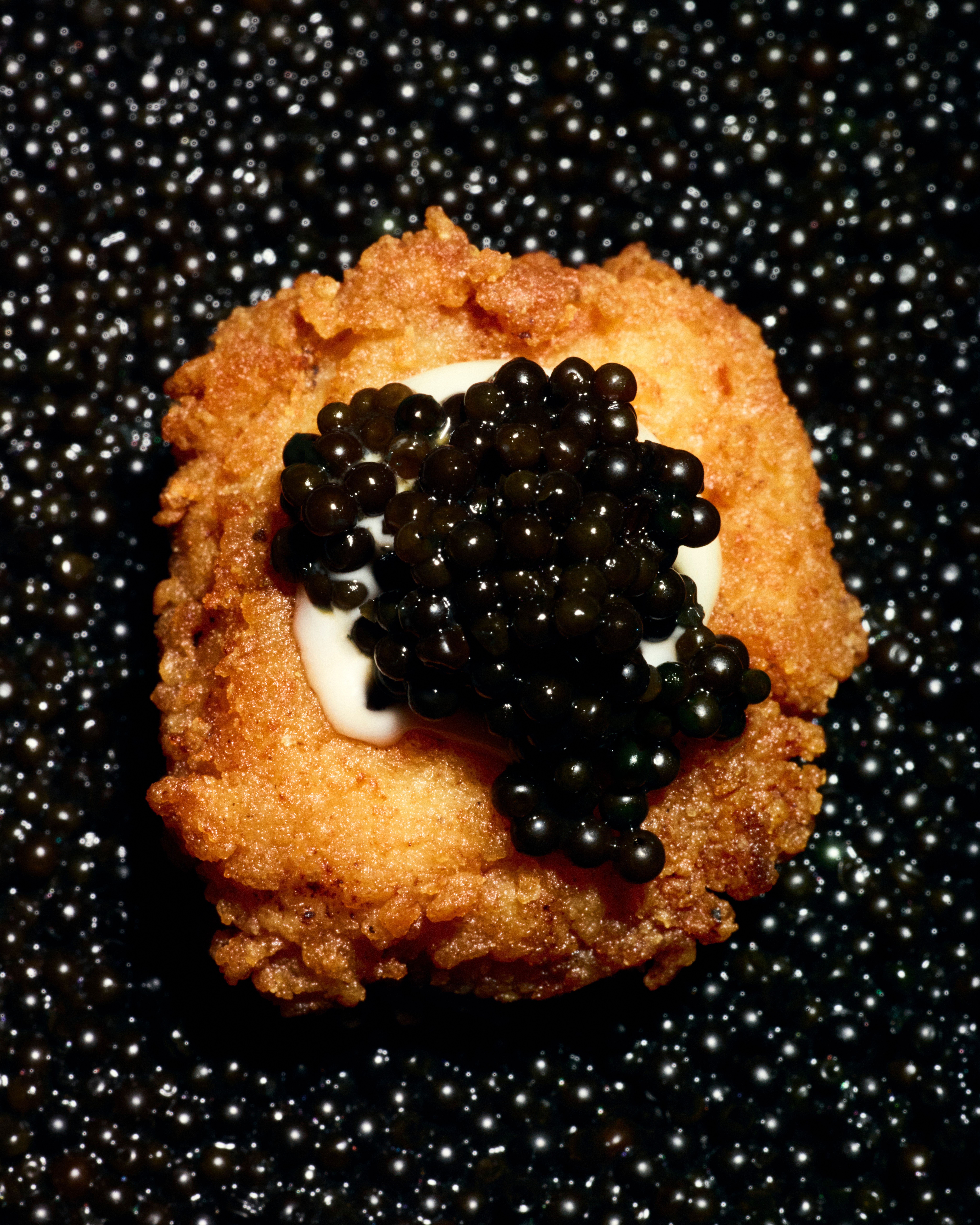when you want, where you want.
CJ Television
Caviar Used to Be Special. Now It’s Just Another Upsell.
 Chicken, with eggs.Photo: Hugo Yu
Chicken, with eggs.Photo: Hugo YuSometime around 2010, the chef Wylie Dufresne and his cooks at the Lower East Side restaurant wd~50 were developing an entrée inspired by leftover fried chicken. They’d take planks of chicken thigh and cook them sous vide. Then they’d bread them, fry them, and chill them. Once cold, the chicken was sliced lengthwise and plated with Tabasco honey and buttermilk gel that held its ricotta-like texture while warm.
Whenever the kitchen staff wanted to steer a new dish into the realm of fine dining, they’d ask themselves the same question: “How do we midtown it?” For the chicken, they midtowned it with a few spoonfuls of American caviar. “Caviar seemed almost like an obvious choice,” says Dufresne, “and fun because from there you go, Ah, surf and turf.” The crispy chicken was cold, the buttermilk was warm, and the different textures worked together: “The same way you can have blini with crème fraîche and caviar,” the chef says.
What Dufresne didn’t realize at the time was that he’d hit upon an idea — just add caviar — that other chefs and restaurateurs would spend the next decade and a half copying and refining into one of the great upcharge moves of our current dining era. At Momofuku Noodle Bar, David Chang unveiled a fried-chicken feast, a platter of bird parts served with biscuits and two types of caviar. A 2016 Wired cover featured an extra-crispy drumstick sticking out of a tin of inky ova. A few years later, a dish of cold fried chicken with caviar and ranch would appear on the menu at the more upscale Momofuku Ko.
Today, the Noodle Bar fried-chicken platter (designed for two-to-four people to share) costs $600, and the biscuits have been swapped out for chive crêpes. I’m sure it’s still good, but it is also no longer particularly novel, as otherwise-casual bars and restaurants all over town have added various caviar supplements to their menus, not necessarily because they’re looking to midtown any particular dishes, or riff on fine-dining tropes, but — from all outward appearances at least — because it’s an easy way to tack on an extra $60, $80, or even $100 to the final bill.
At LittleMad, the menu encourages you to “make it madder” with the option to garnish anything with $20 worth of caviar. Figure Eight’s cooks will add 30 grams of kaluga caviar to its raw-bar tower or its “turnip tots” for $48. During the $112 tasting menu at 63 Clinton, an employee rolls a cart throughout the dining room to prepare optional $55 hand rolls tableside. Hoexters, a throwback comfort-food spot on the Upper East Side, offers a snack of caviar and potato chips for either $95 or $250, depending on the grade of fish egg a diner desires (or can afford). Downtown, the Golden Swan waffle-cuts the chips it sells with caviar and onion dip for $175. Even Dufresne himself is not immune from the city’s caviar bloat: At his pizzeria Stretch, a holiday-season special involved oversized quenelles of caviar plopped down onto slices of everything-bagel pizza.
Taken together, the effect of all these fish eggs swimming around town is the inverse of what happened to wd~50’s chicken: Instead of making dishes feel more rarefied, all the scoops and bumps and optional supplements have made caviar seem ordinary.
“The market used to be a lot smaller, for sure,” says Ian Purkayastha, founder of Regalis, which has sold caviar since 2012. “There used to be two or three competitors in the U.S., now there are 20 or 30.” It’s also become cheaper since around 2017 when Chinese caviar exports ramped up, “flooding the market with inexpensive caviar,” says Purkayastha. Regalis sells Chinese caviar in addition to Dutch farmed caviar that is almost twice the price, but “It’s only when you’re tasting it side by side with something superior” that most people notice a difference. “Which is why a lot of restaurants now use the Chinese caviar: You can put a ton on the plate and you’re not having to charge an exorbitant price compared to what you used to have to charge.”
Of course, it’s never cheap, and restaurants aren’t always transparent about where they buy their caviar: “I’ve had servers tell me on more than one occasion that the caviar is from Russia when it wasn’t,” says Ryan Sutton, the Lo Times critic and caviar enthusiast. (Russian caviar imports have been banned in the U.S. since 2005.) “For what it’s worth, I’ve had really great Chinese caviar, too,” Sutton adds.
One read is that the more affordable products taking over the market have placed a once-exclusive food item within reach of far more people. That is certainly the case at Coqodaq, a new restaurant that’s built its entire business on a three-point plan: caviar, Champagne, and — yes — fried chicken. Alongside ceramic “buckets” of Korean fried chicken in a crystalline shell, diners can order classic caviar service, but why not just cut right to the chase with the restaurant’s “golden nugget,” a by-the-bite order where each piece of chicken is crowned with either trout roe or high-grade stuff from Asia? When I ordered it the other night, I thought of Dufresne’s comments about his own chicken’s temperature (cold) working with the caviar. The hot, plump nuggets overwhelmed the delicacy of the more expensive eggs at Coqodaq, though the larger, more robust pearls of trout roe (while not technically “caviar”) fared better. Neither, however, was more satisfying than the experience of dipping a warm McNugget into a little plastic cup of too-sweet barbecue sauce.
All Rights Reserved. Copyright , Central Coast Communications, Inc.